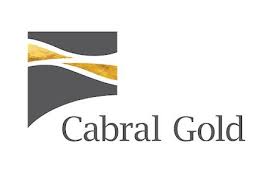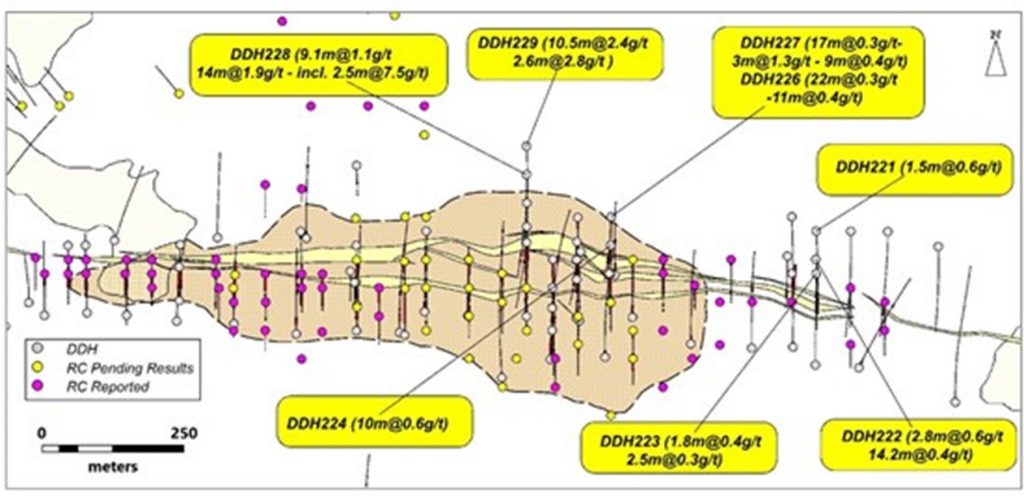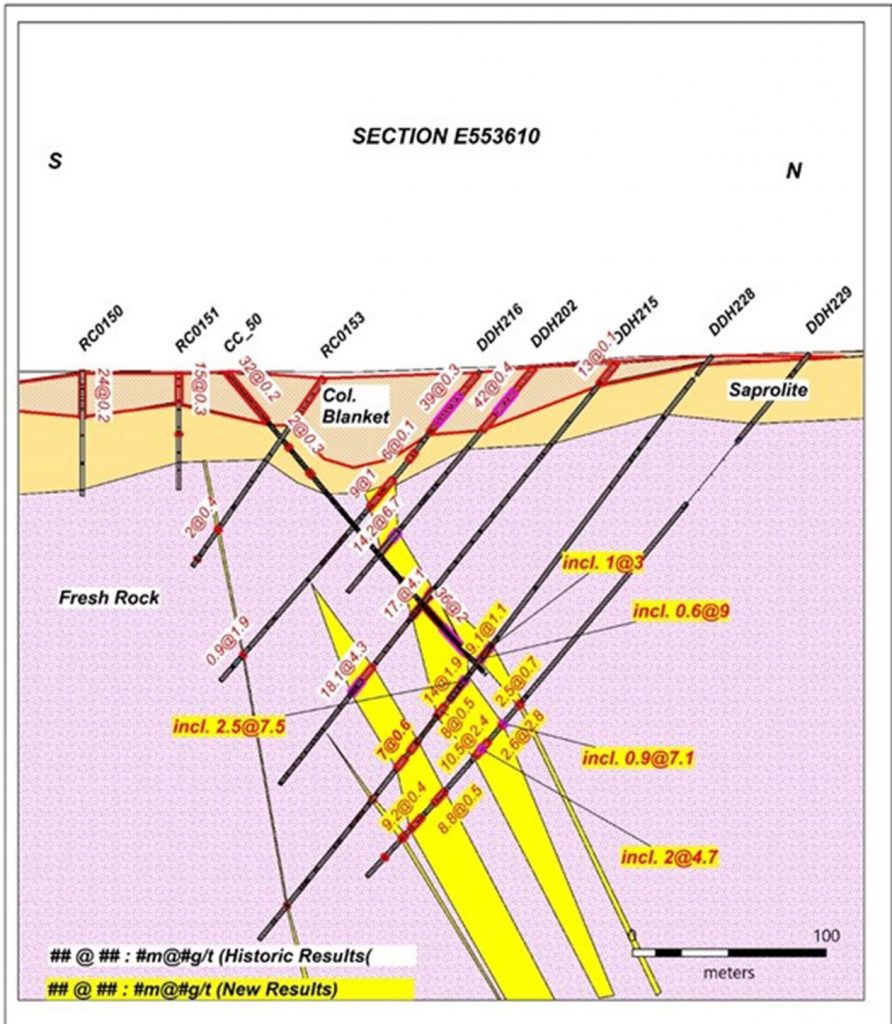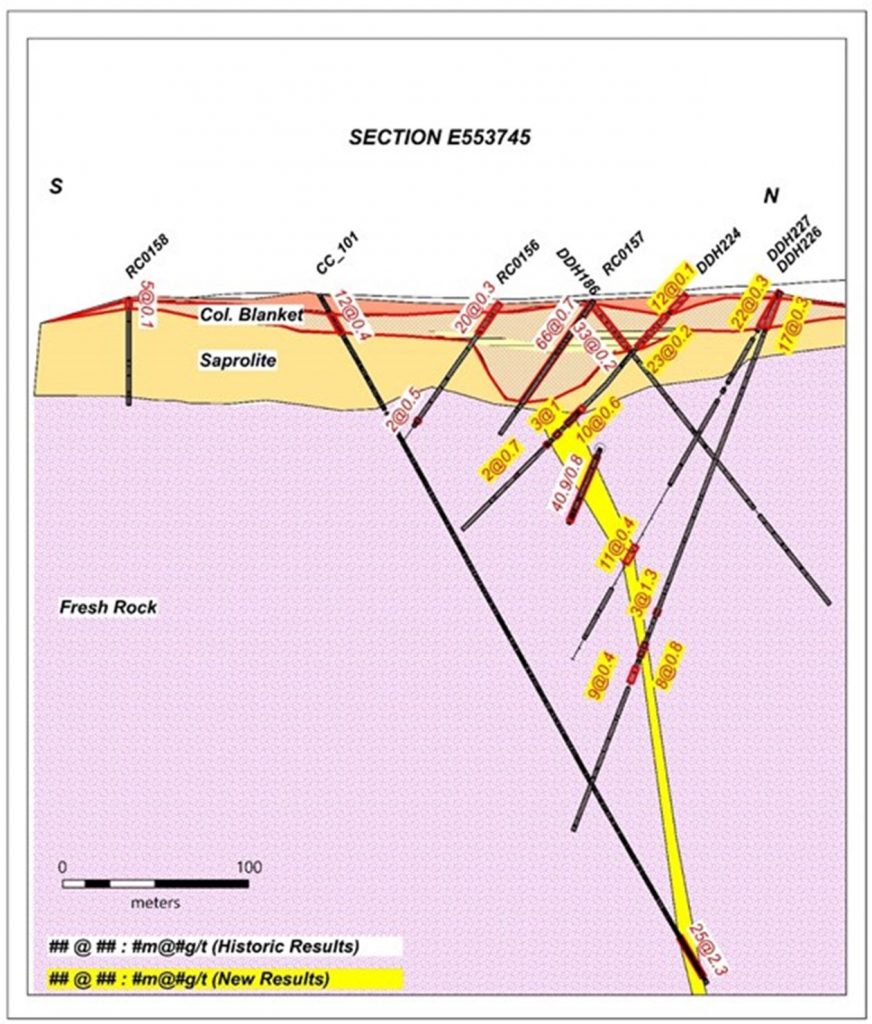
Cabral Gold Extends Primary MG Gold Deposit and Recently Identified Footwall Zone Down Dip, Cuiú Cuiú Gold District, Brazil

Cabral Gold Inc. (TSXV: CBR) (OTC PINK: CBGZF) is pleased to provide additional assay results from nine recently completed diamond drill holes in the primary bedrock MG gold deposit, and within the recently identified gold-in-oxide blanket within the Cuiú Cuiú gold district in northern Brazil.
Highlights are as follows:
- DDH228 drilled at MG returned 9.1m @ 1.1 g/t gold from 187.9m depth and 14m @ 1.9 g/t gold from 208.6m depth including 2.5m @ 7.5 g/t gold. This intercept is the down-dip continuation of the zone intersected in hole DDH215 which returned 17.6m @ 4.1 g/t gold including 1.3m @ 29.5 g/t gold
- DDH229 drilled on the same section as DDH228, returned 10.5m @ 2.4 g/t gold from 258.5m depth including 2m @ 4.7 g/t gold, and 2.6m @ 2.8 g/t gold including 0.9m @ 7.1 g/t gold, and 8.8m @ 0.5 g/t gold. The mineralized zone remains open at depth
- Both DDH228 and DDH229 also intersected the recently identified mineralized zone which sits in the footwall of the main MG deposit and was intersected in DDH215 which returned 18.1m @ 4.3 g/t gold. Both mineralized zones remain open at depth
- DDH226 and DDH227 both intersected significant thicknesses of mineralization within the overlying gold-in-oxide blanket indicating that the blanket remains open to the north-east
Alan Carter, Cabral’s President and CEO commented, “The drill results that we are reporting today from the diamond drilling at MG further extend the main mineralized zone at depth and confirm the presence of a significant mineralized zone within the footwall to the primary MG gold deposit. Both zones remain open at depth. The down-dip continuation of a significant mineralized zone in the footwall to the MG deposit is very encouraging. Elsewhere at MG, the recent diamond drilling is corroborating the recent RC drill results and suggesting that the gold-in-oxide blanket at MG, which overlies the primary MG gold deposit, will continue to grow.”
MG Diamond Drilling
Assay results were returned on nine additional diamond drill holes (DDH221 to DDH229) which were recently completed at the MG gold deposit (Figure 1). The current diamond-drill program is designed to define the limits to the high-grade zones within the existing MG and Central deposits at Cuiú Cuiú.

Figure 1: Map showing the outline of the primary MG gold deposit (in pale yellow) and the interpreted outline of the overlying mineralized oxide blanket (in beige). The results from recently completed diamond drill holes (DDH221 – DDH229) are also shown. Note that DDH225 returned no significant results
Holes DDH228 and DDH229 were both drilled on the same section (553610) located in the central eastern portion of the primary MG gold deposit (Figures 1 and 2). The holes were designed to follow up on previous holes drilled in the same section such as DDH202 which returned 14.2m @ 6.7 g/t gold (see press release dated January 20, 2020) and DDH215 which intersected 17.6m @ 4.1 g/t gold and 18.1m @ 4.3 g/t gold (see press release dated July 8, 2021). DDH215 is of particular significance because it indicates the presence of a new mineralized zone (18.1m @ 4.3 g/t gold) within the footwall to the main mineralized zone at MG.
DDH228 was drilled down dip of DDH215. It returned 9.1m @ 1.1 g/t gold from 187.9m depth and 14m @ 1.9 g/t gold from 208.6m depth including 2.5m @ 7.5 g/t gold (Figure 1). This intercept is the down-dip continuation of the main mineralized zone at MG intersected in hole DDH215 which returned 17.6m @ 4.1 g/t gold including 1.3m @ 29.5 g/t gold. The footwall zone returned lower grade intervals including 7m @ 0.6 g/t gold, but suggests continuity of the zone at depth.
DDH229, drilled on the same section as DDH228, returned 10.5m @ 2.4 g/t gold from 258.5m depth, including 2m @ 4.7 g/t gold, and 2.6m @ 2.8 g/t gold from 246.1m depth including 0.9m @ 7.1 g/t gold (Figure 2). These intercepts represent the down-dip continuation of the main mineralized zone at MG. The hole also intersected 8.8m @ 0.5 g/t gold from 292.8m depth and 9.2m @ 0.4 g/t gold from 310.5m depth. Both the main mineralized zone at MG and the footwall zone remain open at depth.

Figure 2: Cross-section (E553610) through the primary MG gold deposit showing drill results from DDH228 and DDH229 and the continuation of both the main mineralized zone and the new footwall zone at the primary MG gold deposit
DDH226 and DDH227 were drilled on section 553745 to test the north-eastern continuation of the gold-in-oxide blanket (Figure 3) and both holes intersected significant thicknesses of gold mineralization within the overlying gold-in-oxide blanket. Recent RC drilling on this section returned 66m @ 0.7 g/t gold in hole RC157 from 1.0m depth (see press release dated October 14,2021). DDH226 and DDH227 were drilled 100m north of RC157. DDH226 intersected 22m @ 0.3 g/t gold from surface, while DDH227, which was drilled from the same collar, intersected 17m @ 0.3 g/t gold from 4.0m depth. These results indicate that the gold-in-oxide blanket remains open to the north-east.
Both DDH226 and DDH227 also intersected the main primary MG mineralized zone at depth (Figure 3). DDH226 returned 11m @ 0.4 g/t gold from 157m depth. DDH227, which was drilled further down dip returned 3m @ 1.3 g/t gold from 183m depth, 8m @ 0.8 g/t gold from 202m depth and 9m @ 0.4 g/t gold from 216m depth. These results indicate the continuation of the main mineralized zone at depth.
Diamond drilling at MG continues with results pending on an additional nine diamond drill holes.

Figure 3: Cross-section (line 553745) through the primary MG gold deposit and the overlying gold-in-oxide blanket showing drill results from DDH226 and DDH227 and the continuity of the gold-in-oxide blanket to the north and the continuity of the main mineralized zone at depth
| Drill Hole | Weathering | Mineralized Zone | From | to | Width | Grade | |
| # | m | m | m | g/t gold | |||
| DDH221 | Fresh Rock | MG Main Zone | 198.0 | 199.5 | 1.5 | 0.6 | |
| EOH | 285.0 | ||||||
| DDH222 | Fresh Rock | MG Main Zone | 115.0 | 117.8 | 2.8 | 0.6 | |
| 133.4 | 147.6 | 14.2 | 0.4 | ||||
| including | 136.6 | 140.2 | 3.6 | 0.8 | |||
| EOH | 181.7 | ||||||
| DDH223 | Oxide/Saprolite | Blanket | 5.2 | 7.0 | 1.8 | 0.4 | |
| 94.1 | 95.6 | 1.5 | 0.4 | ||||
| 100.5 | 103.0 | 2.5 | 0.3 | ||||
| EOH | 154.7 | ||||||
| DDH224 | Oxide/Saprolite | Blanket | 0.0 | 12.0 | 12.0 | 0.10 | |
| 15.5 | 38.5 | 23.0 | 0.2 | ||||
| 82.0 | 85.0 | 3.0 | 1.0 | ||||
| 85.0 | 95.0 | 10.0 | 0.6 | ||||
| 100.5 | 104.0 | 3.5 | 0.4 | ||||
| 109.0 | 111.0 | 2.0 | 0.7 | ||||
| EOH | 174.5 | ||||||
| DDH226 | Oxide/Saprolite | Blanket | 0.0 | 22.0 | 22.0 | 0.3 | |
| 157.0 | 168.0 | 11.0 | 0.4 | ||||
| EOH | 226.8 | ||||||
| DDH227 | Oxide/Saprolite | Blanket | 4.0 | 21.0 | 17.0 | 0.3 | |
| Fresh Rock | 183.0 | 186.0 | 3.0 | 1.3 | |||
| 202.0 | 210.0 | 8.0 | 0.8 | ||||
| 216.0 | 225.0 | 9.0 | 0.4 | ||||
| EOH | 310.5 | ||||||
| DDH228 | Fresh Rock | 187.9 | 197.0 | 9.1 | 1.1 | ||
| incl. | 188.4 | 189.4 | 1.0 | 3.0 | |||
| incl. | 195.4 | 196.0 | 0.6 | 9.0 | |||
| 208.6 | 222.6 | 14.0 | 1.9 | ||||
| incl. | 208.6 | 211.1 | 2.5 | 7.5 | |||
| 226.0 | 234.0 | 8.0 | 0.5 | ||||
| 249.0 | 256.0 | 7.0 | 0.6 | ||||
| EOH | 380.4 | ||||||
| DDH229 | Fresh Rock | 232.5 | 235.0 | 2.5 | 0.7 | ||
| 246.1 | 248.7 | 2.6 | 2.8 | ||||
| incl. | 246.1 | 247.0 | 0.9 | 7.1 | |||
| 258.5 | 269.0 | 10.5 | 2.4 | ||||
| incl. | 263.0 | 265.0 | 2.0 | 4.7 | |||
| 292.8 | 301.6 | 8.8 | 0.5 | ||||
| 310.5 | 319.7 | 9.2 | 0.4 | ||||
| EOH | 352.6 | ||||||
Table 1: Table of Drill results for diamond drill holes DDH221 to DDH229
No significant results were returned for DDH225
Drilling Update
Miraboa Reconnaissance RC Drilling
Results were returned on 30 shallow reconnaissance holes at the Miraboa target which is located 2.8km south of the Central gold deposit and is the site of extensive and as yet unexplained historic placer gold workings.
Two of the reconnaissance RC holes intersected low grade but significant gold values near surface, including RC182 which returned 17m @ 0.35 g/t gold from surface, and RC128 which intersected 8m @ 0.2 g/t gold (Figure 4). The presence of gold in these two holes may indicate the presence of a near surface gold-in-oxide blanket similar to those identified at the PDM target and above the MG gold deposit, but the bulk of the placer gold extracted from the E-W trending drainage at Miraboa remains unexplained. Further drilling will be required.

Figure 4: Map showing location of shallow reconnaissance drilling (in yellow) at Miraboa target together with historic alluvial (placer) gold workings in streams and gold-in-soil anomaly (contoured). Map shows location of positive reconnaissance drill results
Central Diamond and RC drilling
Following the recent commencement of follow-up diamond drilling at the primary Central gold-deposit (see press release dated October 28, 2021), which is aimed at further defining the high-grade zones at Central, RC drilling has also commenced aimed at testing for the presence of gold-in-oxide blanket mineralization above the primary Central gold deposit. A program of approximately 43 diamond drill holes and 26 RC holes are planned.
PDM (Pau de Merenda) diamond drilling
Diamond drilling is continuing at the PDM target, located 2.5km NW of the Central gold deposit, and is aimed at testing for the presence of a primary gold deposit in the basement intrusive rock underlying the gold-in-oxide blanket. Results are pending on five diamond-drill holes.
MG RC drilling
Results are currently pending on 44 RC holes at MG designed to test the extent of the gold-in-oxide blanket.
Alonso Reconnaissance Diamond Drilling
Results are currently pending on five diamond drill holes which is located 3km SE of the MG gold deposit. Twenty-three samples of this boulder float material previously returned gold values of 11.6 to 200.3 g/t gold (see press release dated February 11, 2020).
About Cabral Gold Inc.
The Company is a junior resource company engaged in the identification, exploration and development of mineral properties, with a primary focus on gold properties located in Brazil. The Company has a 100% interest in the Cuiú Cuiú gold district located in the Tapajós Region, within the state of Pará in northern Brazil. Two gold deposits have so far been defined at Cuiú Cuiú and contain 43-101 compliant Indicated resources of 5.9Mt @ 0.90g/t (200,000 oz) and Inferred resources of 19.5Mt @ 1.24g/t (800,000 oz).
The Tapajós Gold Province is the site of the largest gold rush in Brazil’s history producing an estimated 30 to 50 million ounces of placer gold between 1978 and 1995. Cuiú Cuiú was the largest area of placer workings in the Tapajós and produced an estimated 2Moz of placer gold historically.
MORE or "UNCATEGORIZED"
Kuya Silver Confirms High-Grade Silver-Gold Vein Mineralization at Umm-Hadid with Initial Drill Results up to 1483.9 g/t AgEq over 2 Metres
Kuya Silver Corporation (CSE: KUYA) (OTCQB: KUYAF) (FSE: 6MR1) is... READ MORE
First Phosphate Closes Final Tranche of Oversubscribed Private Placement
First Phosphate Corp. (CSE: PHOS) (OTCQX: FRSPF) (FSE: KD0) is... READ MORE
GFG Receives Final Payment from the Sale of its Rattlesnake Hills Gold Project
GFG Resources Inc. (TSX-V: GFG) (OTCQB: GFGSF) announces that i... READ MORE
Goliath Receives $1,730,882 Through Warrant Exercises, Inclusive Of Crescat Capital A Longtime Strategic And Cornerstone Shareholder
Goliath Resources Limited (TSX-V: GOT) (OTCQB: GOTRF) (FSE: B4IF)... READ MORE
Robex Pours First Gold at Kiniéro on Schedule and Budget
Highlights: Gold bar weighing 2.64 kilograms (85 oz) poured in th... READ MORE












